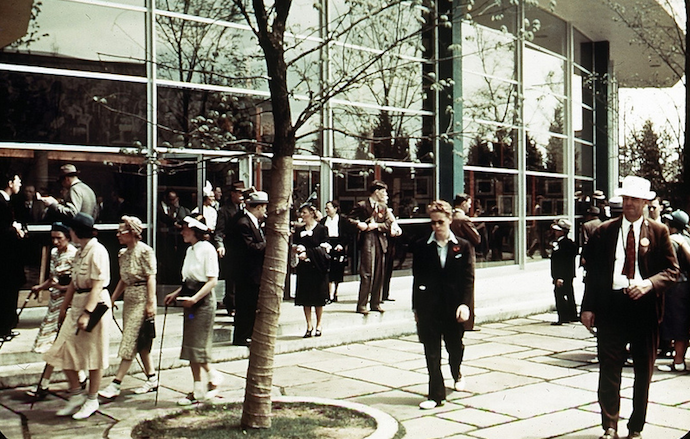World’s Fair Time Capsule To Be Opened In 6939

Image via Flickr/ rich701
Footage has recently emerged from archivist Vincent Romano depicting life in New York at the time of the 1939 World’s Fair. But more than five years ago, another Romano video appeared on YouTube, an excerpt from the 1939 film, “The Middleton Family at the New York World’s Fair,” in which the family looks at the Westinghouse Time Capsule, one of the fair’s main exhibits.
The capsule was created to capture “the spirit of two quintessential American traits: optimism and futurism,” The New York Times wrote in 1939. “The optimistic and forward-looking visions reflected in the 1939 World’s Fair are telling. They suggest Americans were aware that their lifestyles were going to change profoundly in the coming years.”
The time capsule was created to withstand 5,000 years of corrosion and was buried 50 feet under Flushing Meadows Park. It was constructed of an alloy created just for the project, Cupaloy, encompassing copper, chromium and silver. Its contents were sealed inside an insulated air-tight envelope filled with the inert gas nitrogen. Items placed inside the capsule included 75 textiles, fountain pens, metals and plastics, three small newsreels and instructions to create a film projector, seeds from a variety of plants—including wheat, corn, oats, tobacco, cotton, flax, rice, soy beans, alfalfa, sugar beets, carrots and barley—microfilm depicting millions of words from literature, news events, a dictionary, an almanac and a Sears Robuk calendar, as well as a small microscope with which to view it.
What else did the capsule include? Several copies of Life magazine, a kewpie doll, one dollar in change, a pack of Camel cigarettes and even a Mickey Mouse watch were placed inside.
The “key” to opening the capsule in the year 6939 was enclosed in a Book of Record, distributed to more than 3,000 museums, monasteries and libraries around the world. The Book of Record was designed to preserve knowledge of the time capsule’s existence, instructions on how to locate it and a key to the English language—under the guise that the present language may be lost over the next 50 centuries.
In our time many believe that the human race has reached the ultimate in material and social development; others that humanity shall march onward to achievements splendid beyond the imagination of this day, to new worlds of human wealth, power, life and happiness,” the introduction of the Book of Record states. “We choose, with the latter, to believe that men will solve the problems of the world, that the human race will triumph over its limitations and its adversities, that the future will be glorious.”
The book, printed on permanent paper with special ink, also makes certain requests of future civilizations. It asks for its contents to be translated into new languages as they supersede the old, so that whoever might locate it 5,000 years in the future might benefit from its contents, including the latitude and longitude of the capsule’s burying location. It even provides an astronomical description of the time it should be opened, should present methods of determining time be extinct in 6939.
The capsule items perhaps most moving, however, are the written messages from three important men in the late 1930s: physicists Albert Einstein and Robert Andrew Millikan, as well as novelist and social critic Thomas Mann.
Our time is rich in inventive minds, the inventions of which could facilitate our lives considerably,” Einstein wrote to future civilizations. “We are crossing the seas by power and utilize power also in order to relieve humanity from all tiring muscular work. We have learned to fly and we are able to send messages and news without any difficulty over the entire world through electric waves. However, the production and distribution of commodities is entirely unorganized so that everybody must live in fear of being eliminated from the economic cycle, in this way suffering for the want of everything. Furthermore, people living in different countries kill each other at irregular time intervals, so that also for this reason anyone who thinks about the future must live in fear and terror. This is due to the fact that the intelligence and character of the masses are incomparably lower than the intelligence and character of the few who produce something valuable for the community. I trust that posterity will read these statements with a feeling of proud and justified superiority.”
Millikan chose to describe the current state and potential of world governments:
At this moment, August 22, 1938, the principles of representative ballot government, such as are represented by the governments of the Anglo-Saxon, French, and Scandinavian countries, are in deadly conflict with the principles of despotism, which up to two centuries ago had controlled the destiny of man throughout practically the whole of recorded history. If the rational, scientific, progressive principles win out in this struggle there is a possibility of a warless, golden age ahead for mankind. If the reactionary principles of despotism triumph now and in the future, the future history of mankind will repeat the sad story of war and oppression as in the past.”
Mann’s message, however, was by far the most profound:
We know now that the idea of the future as a ‘better world’ was a fallacy of the doctrine of progress. The hopes we center on you, citizens of the future, are in no way exaggerated. In broad outline, you will actually resemble us very much as we resemble those who lived a thousand, or five thousand, years ago. Among you too the spirit will fare badly. It should never fare too well on this earth, otherwise men would need it no longer. That optimistic conception of the future is a projection into time of an endeavor which does not belong to the temporal world, the endeavor on the part of man to approximate to his idea of himself, the humanization of man. What we, in this year of Our Lord 1938, understand by the term “culture” a notion held in small esteem today by certain nations of the western world is simply this endeavor. What we call the spirit is identical with it, too. Brothers of the future, united with us in the spirit and in this endeavor, we send our greetings.”
The Westinghouse Pavilion in which the time capsule was displayed in 1939 is long gone, but the site of its burial is marked by a concrete marker in the park at Flushing Meadows. A twin was placed just 10 feet to its north in 1965 when the World’s Fair again visited New York. The second capsule added descriptions of atomic energy, scientific developments and space travel. An addendum to the original Book of Records was also created to avoid possible confusion between the two capsules and sent to the same 3,000 depositories.
Will there still be life on Earth able to uncover and decipher the time capsules in 6939? Will there still be an Earth from which to uncover them? Or were inhabitants of 1939 far too optimistic in the world’s future? Less than a century later, we may picture a different fate.









































